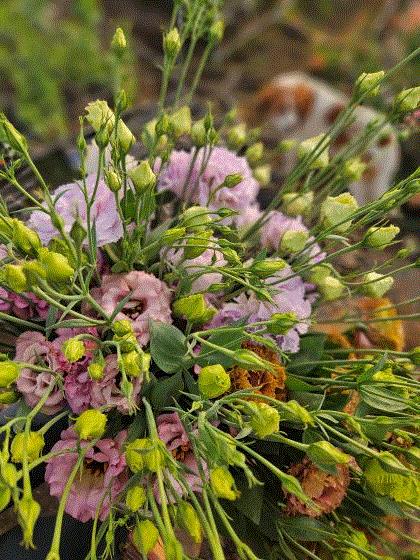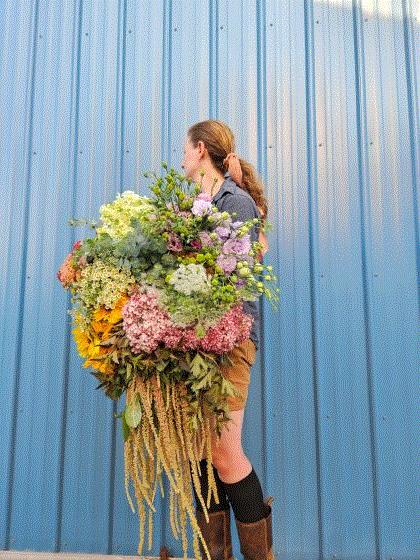End-of-June Farm Update

The first handful of lisianthus for 2025!
Welcome to summer solstice and the start of peak season! Tater and I spent quality time hoeing the dahlias, putting together irrigation lines, and barely managing to keep our sow schedule on track. Trust me, execute your sow plan at all costs—your cash flow this fall will thank you for the foresight!
It's hard to think about fall when you are frying under the June heat dome. It was a scorcher this week, and to be honest I was contemplating my life choices. We had heat indexes at 100F or more for five consecutive days this week. That kind of heat is hard on the people, the plants and the flowers. But Team Forget Me Not and Tater knocked it out of the park! However, we were living on bottled water and Tropical Smoothie to get us through each day.
We sent out our last peony stems this week and the outdoor dahlia field is starting to bud up. The heat will probably knock out the sweet pea, but we cut our first bunches of lisianthus. That’s a trade I am willing to accept.
Oh, remember that Preforma plug trial I talked about in the April edition of Bloom Beat? Tater and I look forward to seeing the result of this experiment and will tell you all about it next month!
I saw a post on Facebook that made me laugh so hard I almost cried. Shout-out to
Sharkey’s Greenhouse for the laugh, I felt so seen:
Them: “I bet owning a greenhouse is fun, what's it like?”
Me: “Have you ever been cremated?”
Tater and I hope you are balancing the heat and the workload. I’ve said it once, and I’ll say it again—farming isn’t for the faint of heart.
In this edition of Bloom Beat we're talking UPC's, Sustainabloom, American Grown Flowers Month and more. With all that being said, let's talk shop!

Social Media Tips for American Grown Flowers Month
The folks at
Certified American Grown have some tips and tricks to help us flower farmers and vendors promote our American grown flowers in the month of July. If you’re wondering how you can join in on the fun, check out the prompts below to help you craft your posts.
According to Anna Kalins, program manager for American Grown, “In an era where digital connectivity is paramount, it’s time to leverage the power of social platforms to highlight the significance of American-grown flowers and foliage. We are excited to see farms and vendors come together to share their stories, showcase their stunning blooms, and gain the recognition they deserve.”
Here's how you can do just that:
Week 1 – Showcase Varieties. Farms and vendors are invited to spotlight the varieties they grow and sell. Share images and descriptions of beloved flower and foliage varieties, provide behind-the-scenes glimpses, and engage audiences with fun facts and trivia.
Week 2 – Share Your Story. Connect with your audience on a personal level by sharing the unique journey behind your farm or shop. Highlight your origins, values, and the dedicated team behind your business.
Week 3 – Facts & Stats. Educate your audience about the American Grown floriculture industry. Share interesting facts, industry insights, and the impact of supporting locally grown flowers and foliage. Highlight sustainable practices and the role of American Grown floriculture in supporting local communities.
Week 4 – We Are American Grown. In the final week, we will deliver a powerful, unified message celebrating the beauty and impact of our collective efforts. Farms and vendors are encouraged to post the same message with a captivating picture of their farm or shop.
Be sure to tag @americangrownflowers and use the hashtag #AmericanGrownMonth. For resources and details such as graphics, materials and ideas, check out the American Grown Month Toolkit, now available on the Certified American Grown
WEBSITE.
Join in celebrating the diversity and splendor of American Grown flowers and foliage! Together, we can cultivate the American Grown Movement, elevate awareness, and celebrate the artistry and dedication behind our homegrown floral industry.
Learn more and get the toolkit
HERE!

All About UPCs
Are you thinking about approaching a new grocery store client this season? Tater and I started Forget Me Not as a wholesale operation, and once we started working with grocery stores our flower farm took off. We sell thousands of sunflowers and dahlias a week, thanks to our grocery clients. It’s a great way to move volumes of flowers ... but you need to lay some groundwork first.
Before you approach a prospective grocery store client, you need to learn about their product packaging requirements. Usually, you need a Universal Product Code (UPC for short) for your products. UPC is an alphanumeric 12 digit barcode that identifies your product. The good news is, getting a UPC isn’t as complicated as you might think!
There are three components to a UPC code. First is the company prefix, followed by the product reference number, and then a check digit at the end.
Most grocery stores will require you to have your own
GS1 prefix. The GS1 prefix ensures your barcodes are globally unique and are the prefix for your UPCs.
The initial cost for a GS1prefix for less than ten products is between $250 and $750, with a $50 annual renewal fee. If you have a hundred products or more it can be upwards of $800. So the startup cost can be pricey, but if you want to get into groceries, this is likely a necessary step.
The second component to a UPC is the item reference number. You create this number to identify each bunch type. Last but not least is a check digit. The check digit makes the barcode scannable and is calculated by a mathematical equation. The good news is that GS1 has a free check digit calculator which simplifies this. If you are a barcode nerd and want to know more about the math, I recommend asking Google, because it’s a long explanation. I’ll save you the hassle, just use the free calculator.
Quick note about UPCs vs. SKUs: UPCs are the printed barcodes on the sleeve that get scanned at checkout to reveal the price. UPCs are universal codes that identify your products across different retailers. SKUs, or Stock keeping Units, are unique to each retailer and are used for inventory tracking and management. Retailers create their own SKUs, and the same flower can have different SKUs depending on the color or bunch size. The UPC stays the same across all retailers to identify your product. SKU’s assist with inventory management for you and the store. Things can get kind of wild when you have a SKU for your farm and the Store SKU and the UPC on the same sleeve.
To put it simply, SKUs show up on harvest sheets, packing slips and invoices. UPC is the barcode on the sleeve that gets scanned at check out.
Check out this
ARTICLE from QuickBooks for a deep dive on the differences between UPC and SKU. Tater and I hope this helps!

New Sustainabloom Resources
Our friends at
Sustainabloom have two new guides to help our industry continue to grow and thrive.
American Floral Endowment started the nonprofit Sustainabloom in 2022 to support scholarships and research, and to create guides and resources to promote sustainability in the floral industry. Sustainabloom strives to make “sustainability doable for everyone in floriculture, offering resources that are easy to understand regardless of business size or scale.”
These two new guides do just that. The
Cold Chain Management Guide outlines the key components of flower storage, temperature and sanitation practices. This is a great tool that I will be sharing with Team Forget Me Not. It’s important for employees to know why we do certain things as well as how to do them. A little understanding goes a long way and pays dividends for your bottom line.
For those of you looking for an alternative labor source, the folks at Sustainabloom also have a new
H2A and H2B Guide. This serves as a great primer for understanding the difference between the two programs. Government issued H2A visas have skyrocketed from 2020-2022. It’s becoming a popular solution for labor shortages on farms. If you are interested in learning if H2A is a possibility for your farm, this guide is a great place to start.
You can find Sustainabloom’s extensive resource list
HERE.

Summer Solstice Musings

The summer bounty is starting at the farm. Just in time for the heat wave.
The heat wave this week made me think a lot and reflect on what it means to farm flowers. One of the many reasons why our farms are so special is that there is a face associated with each bloom we deliver. Our best customers are not only invested in the flowers we sold to them that week, they also relish watching the farm grow and prosper, and they buy into the mission of Michigan-grown flowers. We’re partners, not just another vendor.
Team Forget Me Not and our clients strive to give people the best, longest-lasting flowers on the market. Each bloom that we deliver has a piece of Tater and me associated with it. Isn’t that the case with all flowers? There’s a piece of a grower with each stem. I think consumers and florists alike forget that there is a face behind every flower they receive—even the ones that come in boxes.
The crazy heat wave this week made me think about what it would be like to farm in other parts of the world, and how some folks along the equator contend with these conditions every day. Some of our clients were astounded that we were working full days in these sweltering conditions. Folks don’t realize what it takes to grow the flowers. I realized this week that even the common staples such as standard roses and carnations can't be taken for granted.
Tater and I want to hear from you: How do you think we can communicate as industry what farming is like? Flowers are romantic and somewhat whimsical, but the process to create them is arduous and unrelenting. This is weighing on my heart and I would love to hear what you think. Is this even a worthwhile pursuit? These musings have been playing on my mind all week, and we would love to bounce ideas off of you. Email us
HERE if you have ideas or just want to share what's on your heart about the topic.

Until next time,
Lindsay Daschner (and Tater)
Editor-at-Large—Bloom Beat
Owner—Forget-Me-Not Farms
This email was received by 6,250 of your fellow fresh-cut flower growers!
If you're interested in advertising in Bloom Beat, contact Kim Brown and she will hook you up!